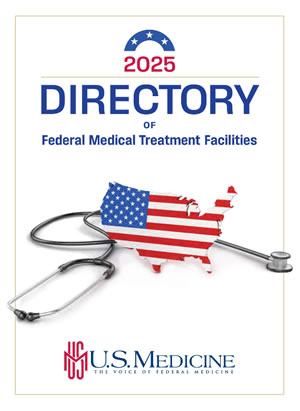Profoundly Altered
By April 23, the DCVAMC had 183 positive coronavirus cases and 15 deaths, and the hospital and its staff had been profoundly altered.
“Our census is at about 50% of what it was pre-COVID,” Heimall explained. “We’ve gone from running five to six ORs a day to running three, and the volume is down significantly. A lot of people are staying away.”
Veterans who come in are all screened for coronavirus, either in a negative pressure suite in the hospital’s research building or, in the case of patients who need additional work-ups, in the facility’s decontamination trailer.
Nonessential surgeries have been postponed and a strict no visitor-policy is in effect, with only a few exceptions made, like in the case of hospice or end-of-life care.
“We also make some limited exceptions for bedside essential caregivers,” Heimall explained. “Occasionally we have a patient who thrives if there’s a known family member with them. We give them the PPE (personal protective equipment) to protect themselves and allow them to be with their veteran. Those have been the only exceptions.”
The cascade effect of the changes required to care for coronavirus patients has spread far and wide. On the fourth floor, in what is now the COVID-19 ward, lessons are being learned every day in how to adapt to the pandemic.
“We had to relocate ward teams, so we’ve had to turn a number of conference rooms and vacant rooms off of the wards into office space to use, to minimize the risk of exposure when these teams are not working with a patient,” Heimall explained. “Our IT staff has been working overtime to set those things up.”
Even the way the hospital dealt with codes has had to be rethought.
“We’ve had to change up code processes for cardiac arrest,” Heimall explained. “If you’ve got a code on a patient in a negative pressure room, it’s hard to get the whole code team in proper PPE in there at once.”
Consequently, the hospital limited code responders to three people in the room. Code bags are now stocked with walkie-talkies so that if something is needed—a medication on a cart outside the room, for example—the team can call for it. Using walkie-talkies was something Heimall had learned during his time as the commander of the William Beaumont Army Medical Center in El Paso while training for Ebola preparedness.
“That was one of the things we worked very hard on,” he said. “How to code and how to communicate with providers outside the room.”
The hospital also has had to build a back-up code team in the event of simultaneous codes in the ward.
“We’re not used to having multiple codes here,” Heimall said. “For the last seven days we’ve been between 22 and 26 COVID patients, and we’ve found we’ve had multiple simultaneous codes going on.”
Depending on which model you look at, as of April 23, Washington, DC, had either just passed its infection peak or the peak was still four to six weeks away. Heimall and his team were preparing for the latter, with contingencies in place in case the situation worsened.
The hospital’s ethics committee had formed a strategic resource allocation subcommittee and was looking at how to handle life-sustaining measures during a massive surge of patients. For example, how do you handle veterans with DNRs or those with no next of kin to consult?
“Also, while I don’t want to use the word rationing, we are tightly controlling how and where we use PPEs so that we have them for the people at the greatest risk,” Heimall said.
As of April 23, the hospital had about 30 staff members who had tested positive. Heimall is working under the assumption that all of them caught it at the hospital.
“Interestingly, the folks on the fourth floor are the smallest percentage of that group,” he noted. “That tells you something about the asymptomatic transmission that can go with this and what makes it so challenging.”
“Early on, the challenge we had was a veteran would show up with no symptoms,” he explained. “One of the first patients that tested positive was admitted for stroke, then within 36 hours started showing symptoms. That puts your staff at a lot of risk. You don’t expect COVID-19, so you’re not using precautions. Seeing things like that, we made the decision in early April to go to universal masking in the hospital.”

